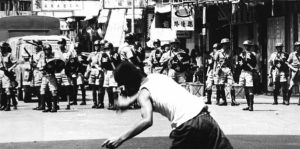
Public Lecture
Friday, 4 October 2019, 12:00–2:00 pm
Riot, Refugee, Fire: The Borderscape of Hong Kong 1950s
Dr. Kenny K. K. Ng (Hong Kong Baptist University)
120, C. K. Choi Building, UBC
1855 West Mall, Vancouver
Free and open to the public
A City in Protest event
This talk examines Cold War borderscapes and cinematic expression in colonial Hong Kong. Whereas an ideological fortress separated leftist and rightist organizations and partisans, the frontier between the People’s Republic of China and colonial Hong Kong was an unsettled space of contestation in the early 1950s. The border was itself a space of physical confrontation, kidnapping, and armed conflict between British and Chinese troops. The massive “illegal” influx of Chinese refugees from the mainland into Hong Kong was referred to by the US as “refugees from the Free World.” Numerous destructive fires in the squatter settlements alarmed the US and PRC governments sufficiently to send humanitarian aid to the colony. Meanwhile, colonial officials refused entry to Hong Kong to PRC “comfort delegations” which sought to visit fire-struck, homeless people, in turn provoking riots in the border regions. Conspiracy and paranoia reigned in the government’s anti-communist measures in social and cultural fields, and this saw the swift deportation of mainland film workers together with protest leaders of fire victims in 1952.
The talk asks how borderscapes and social crises structure film narratives and frame cinematic imagination. The notion of borderscape relates not only to socially produced and constantly redefined territorial borders in their Cold War connections, but it also emphasizes the malleable boundaries of texts, artefacts, discourses, and imaginaries that are challenging what is socially and culturally prohibited, regulated, or artistically negotiated on political allegiance and individual identity politics. The second part of the talk will discuss the Mandarin-speaking film Halfway Down [Ban xialiu shehui] (1957) produced by American-financed Asia Pictures in the “rightwing” camp, which narrates the plights of exiled intellectuals fleeing their mainland homes to sojourn in a ghetto in colonial Hong Kong. Regardless of the ideological orientations, the film was a tenement drama about migrants and exiles seeking moral reformation and collective union. While the movie was being made in 1956, the Kowloon riots erupted during Double Ten Day (October 10) as ignited by escalating provocations between pro-Nationalist and pro-Communist factions in the city, forcing British armored troops to intrude and quell the rioting, which led to 59 deaths including Europeans and Chinese. Within the regulative frame of Cold War politics, this paper asks, can the film move beyond political allegory to global storytelling of diasporic Chinese subjects and communities? Can it provide a possibility of border-thinking to counteract nationalism and political propaganda? How do refugees and exiles mobilize storytelling and images to contest the meaning of being Chinese?
Kenny K. K. Ng 吳國坤, Associate Professor in the Academy of Film at the Hong Kong Baptist University, obtained his Doctoral Degree (East Asian Languages and Civilizations) from Harvard University. He teaches comparative literature, film studies, visual culture, and Hong Kong cinema. His first book, titled The Lost Geopoetic Horizon of Li Jieren: The Crisis of Writing Chengdu in Revolutionary China, was published by Brill in 2015. He has published widely on film culture and modern Chinese cultural and literary studies in the U.S., UK and Europe, China, Taiwan, and Hong Kong. His ongoing research book projects concern censorship and visual cultural politics in Cold War China and Asia, and a critical history of Cantophone cinema.
This public lecture is co-sponsored by the Department of Asian Studies, Centre for Chinese Research, and Hong Kong Studies Initiative.